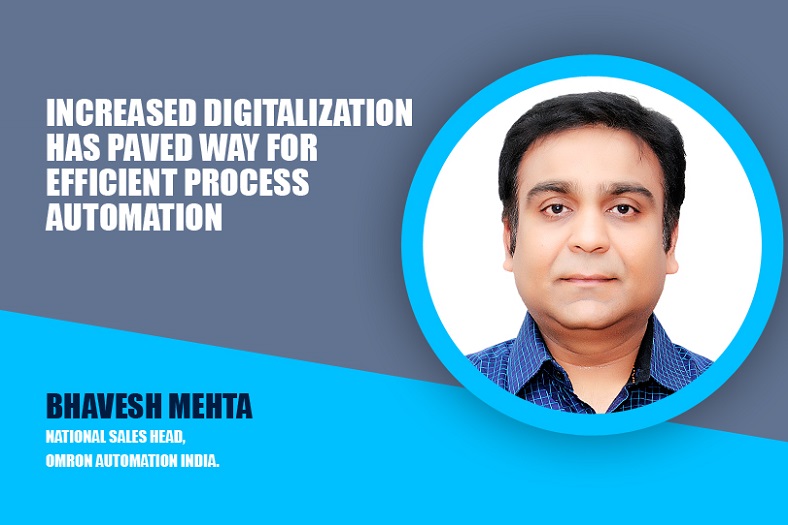Increased digitalisation has paved way for efficient process automation
By OEM Update Editorial November 30, 2021 7:48 pm IST
Opportunity and challenges lie in the education, skill and training of the employees’ visà-vis employers to enhance their digital skills.
What is your perception about the automation and robotics market with increasing digitalisation?
As the technological succession has become more rapid, the pace at which the industry is evolving has increased substantially. Just about a few years back we were discussing Industry 4.0, which included a digital network of machines, products and IT network. IoT and IIoT domains were established that included the consumer goods sector and industrial manufacturing sector respectively.
Now, Industry 5.0 is an extension of its previous tier I4.0 which augments the automated and smart machines technology with that of the creative potential of human beings. It could be said that Industry 5.0 is the complete realisation of the power of automation and increased digitalisation that was envisioned during Industry 4.0.
Increased digitalisation has paved the way to have efficient process automation. It helps industries to identify inefficient processes and parameters quickly and optimise the same that saves time and cost for the industry. From the perspective of our company that provides field instrumentation, digitalisation has played a big role. We can integrate our sensors delivering reliable and precise solutions into existing systems. Such solutions save cost and time for our customers and reduce or eliminate downtime, which otherwise would be inevitable in the absence of such solutions.
To ensure safety and security what measures will you suggest to manage automated industries in manufacturing?
Safety and security are the necessary drivers of automation. In the absence of automation, a problem in a critical process would go unnoticed until it assumes a larger proportion, which potentially would make the process environment unsafe for the workers. Automation also eliminates human errors, thereby providing another level of safety. Internet-based solutions also impart data security when we opt for data transfer via secured line. Additionally, it also helps in faster data exchange giving more control to the process handler for faster decision making.
Another path-breaking technology is Bluetooth connectivity. For example, VEGA offers a large number of sensor portfolios with optional bluetooth functionality. This helps in installing these sensors in otherwise inaccessible or hazardous areas to better control the processes. Additionally, as Bluetooth is already securely encrypted at the interface level providing necessary data security.
How far are Indian SMEs prepared for industry 5.0? I think Indian SMEs have realised the power of Industry 4.0. With the advent of newer cost-effective automation solutions, SMEs now have started adopting these solutions. This paves the way to be ready for Industry 5.0 for these SMEs.However, there is still a large scope for the adoption of automation and digitisation technology for the Indian SME sector. How SMEs can reap a competitive advantage with the help of automation solutions has to be demonstrated effectively. Another opportunity and challenges lie in the education, skill and training of the employees’ vis-à-vis employers to enhance their digital skills.
Many see technology and digitisation being a key factor in driving the sector’s growth? What’s Your Opinion?
The advent of the internet helped the industry to come up with many automation based solutions. Digital transformation is directly responsible for the rise of IoT and IIoT based products in consumer goods and manufacturing domains. The digitalised solutions help in optimising the entire value chain in the product life cycle. This has also helped organisations to adopt such a solution cost-effectively.
For example, VEGA’s PLICSCOM® display and adjustment module, which communicates wirelessly via bluetooth to the level sensors, is backward compatible, i.e., it can be applied to older devices that VEGA has supplied as far back as the year 2003. Hence, this helps companies to just change the module instead of replacing the entire device, thus saving time and cost.
Can you share challenges and opportunities in adopting factory automation and robotics for manufacturing units? The major challenges to adopting factory automation to manufacturing units lie in the lack of a skilled workforce, the cost of automation itself and the safety and security of the workforce handling the automation processes. As delineated in an earlier section, training becomes pertinent to employees and employers alike to comprehend the automation technology.
As technology is changing at a rapid pace, training becomes a continuous activity for the organisation. A safety audit then needs to be conducted at regular intervals to check the adherence to the processes laid down. Last but not least is – understanding the critical processes and ROI of the automation solution. Not all processes require automation. Also, the selection of the automation technology takes the center stage to check whether it can be directly integrated into the existing set-up without any additional or with minimal infrastructural changes at the manufacturing site.
What future do you see for humans interface with machines and robotic displacing physical workers?
The next industrial revolution is having fine coordination between the human workforce and automated tools. A few processes will see physical workers being replaced by an automated solution. However, this will also create new roles in the industry. Increased automation will help organisations and people to focus on more critical value-added actions. However, the role of training for the skill development of the stakeholders cannot be stressed enough.
Cookie Consent
We use cookies to personalize your experience. By continuing to visit this website you agree to our Terms & Conditions, Privacy Policy and Cookie Policy.


















